Hi Everyone,
I've been chomping at the bit to get out locally to do some fossil hunting here in Clallam County and finally managed to do exactly that. The day was the 12th of December. It'd been cold leading up to my day of exploration and with the tides achieving their lowest status, usually during the evening this late in the Season, I knew it'd be a full day. The problem was, I wasn't sure when I'd reach the beach or even if I would as I had quite a bit of work ahead of me. A few years back, my access route, at least to this special section of beach, had been severely compromised by a large landslide which paralleled the trail. Massive timber falls resulted from the slide which partially blocked my path, making for a much tougher descent down to the beach. Where I'd once had a wonderful trail accessible to everyone, my dogs included, now all that was left was a scraggly path leading to masses of fallen timber which had become quickly overgrown by a thick barrier of thorny plants as a near-impenetrable wall of ickyness which I'd have to find/fight a way through if I was going to find anything. To achieve this, I'd brought a number of tools to cut and excavate.
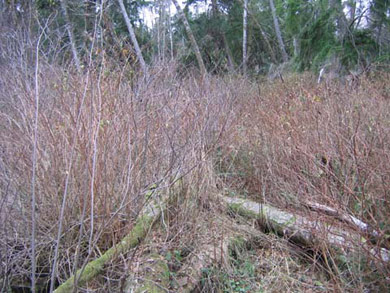
I'd left home mid-morning and was soon on site and eager to begin the work required to achieve my goal. First, and with camera in hand, I made a reconnaissance run down the trail to realize the current conditions and was pleasantly surprised to find things not quite as bad as I'd envisioned. Wearing work clothes with boots, a heavy pair of gloves and an old trashed coat, after a moment's assessment, I forced my way forward and began the task of breaking trail. It was a slow maddening path I wedged, branches and sapling trunks whipped about while a million tiny thorns cut and scratched. More than once, the stinging slap of a branch stung and even through the gloves, the thorns stabbed and bit as downward, ever downward, I worked my way deeper into the wild.
I'm not sure how long it took, but the sweat was freely flowing by the time I first caught sight of the beach. It'd been a battle (and this was just my first run through, I'd still have to fight my way back up to the truck, clearing as I went, to get my pack and tools to start all over again), but it was sure nice to see the water and the beach proper... like seeing an old dear friend whom I've sorely missed.
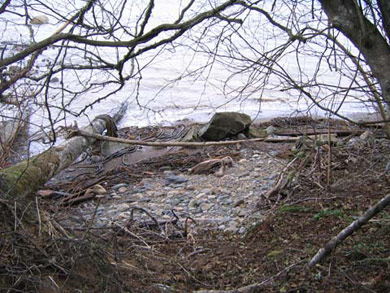
The tide was still relatively high and I'd have plenty of time as it receded to finish the work I'd begun, and so, without further to-do, I set to it. And time passed...
When finished, it wasn't pretty, and come Spring, with the mad invigorating rush of plant growth guaranteed to occur, it wouldn't last, but for the time being, I had a decent trail cut. I'd left the upper reaches ugly so as to distract the casual road-side explorer, but down lower, nearer the beach itself, I'd made a much cleaner, clearer path. And now, down on the beach, the waves lapping at my feet, the Gulls crying from further out beyond the surf, thick in the midst of the stench of decaying seaweed sweetly accented by the tangy smell of the saltwater, I knew I'd made it, that my every straining effort had been worth it, I was back and I was excited... there were fossils out there just a' waiting and I wasn't about to disappoint!
Giddy, I rambled about for a bit looking/hoping for an obvious gift from the Fossil-Collecting-Gods. Not finding it, I next set my steps west and off I went. I had an area along this one special little strip of Juan de Fuca beach that I wanted to check and it was here I'd first explore. Over the years, I've found a rare and diverse assemblage of fossil treasures here, some even new to science and as yet undescribed (as an example and being worked on as I write, a new species of hermit crab I found still partially enclosed by its stolen shell home). Not having been on the beach in such a long time, I was anxious and hopeful that something new had been exposed!
As I walked and since my last visit, I noticed several new, active mini landslides which had deposited/were depositing new accumulations of fresh treasure-bearing sediments down to the beach terrain. Here they were being slowly worked by the wave action of incoming and outgoing tides. Broken down, the relatively soft clay is soon carried away while left behind, the heavier things, rocks, fossils, even crystals, are left. As I walked, I constantly cast my eyes about, always alert for any sign of treasure. And it wasn't long before neat little goodies started to appear, crystals first and then after, the fossils started to make an appearance. Smiling, it was good to be back!
My first finds were of brown opaque crystals, complex members of the mineral world, pseudomorphs of calcite after ikaite. This little hot-spot is one of the World's best when it comes to these crystals due to the incredible diversity of crystal forms seen in specimens recovered here. Twinning is common as are single doubly terminated crystals in approximate sizes ranging from half an inch to extreme examples nearing four inches. Specimens are most easily recovered from the loose beach gravel and at times can be quite plentiful. Formed within the clay, they can often be found protruding from fresh exposures. Being a soft mineral however, they quickly weather as they're washed about, sharp edges round and individuals are often found cleaved in cross-sectioned samples, still, at their best, they are a wonderful expression of the diversity and complexity one encounters when studying the unique treasures discovered along the peninsulas beach's.
Pocketing several specimens, eagerly I continued west. About me, and reflecting the cold wet conditions we'd been enduring of late, many sections of bluff were decorated by bright white ice flows, some quite impressive and picturesque. One had ice-cycles nearly a dozen feet long which made for a wonderful photo.
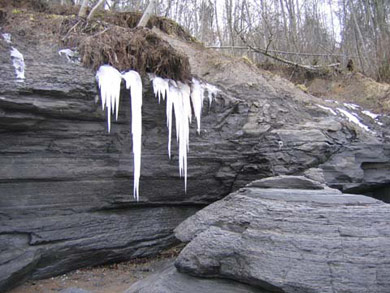
As I neared the area of my focus, I slowed down my advance and really began to systematically scan the ground about me for treasure. Many large blocks had toppled from the slowly advancing face of the sliding bluff beside me. Each block was a potential treasure chest of goodies and carefully I scanned their outside edges looking for obvious signs that treasure lay within. In this way, I noted frequently the partially carbonized remains of compressed fossil drift wood, often wreathed by an encircling ring of barnacles. While interesting, these were not the prizes I sought, I was looking for a much rarer treat, fossil starfish and soon, my search was rewarded as I spied a soft brown colored streak along the edge of one blocks side, upon closer examination, the distinct form of an Oligocene starfish was revealed. I snapped off several pictures before moving on. Like the wood, as weathered, the starfish was unrecoverable, cracked and swollen, its clay matrix would break into a million tiny pieces and would crumble away were I to attempt collection. Some preservation scenarios allow for successful recoveries, unfortunately this wasn't one of them. Undaunted and thrilled for having seen it, one of the sea's most rare fossils, I continued on.
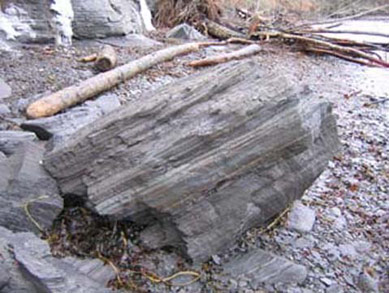
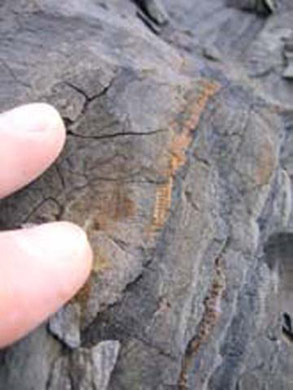
As I worked the area, I noted a wonderful large exposure of fossilized wood. It was compressed into a flat sheet-like shape encapsulated within the clay and was over six feet long and near four wide. Much of it was carbonized and black as night, while other areas still retained remnant wood structure and grain. Again, much of the logs outer surface was coated by fossil barnacles. Easily damaged, fossil barnacles are only rarely found perfect and pristine. My best samples, from this same location, were exposed under the lip of a clay mass. The waves would slosh upwards in gentle splashes, loosening the matrix from around the fragile edges of the barnacles shell. Several exceptional specimens were recovered from this one-time lucky discovery.
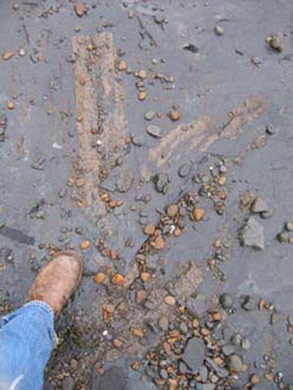
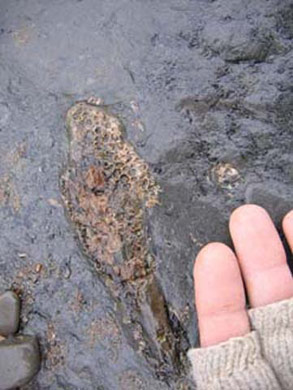
I spent a good chunk of time casting about, but in the end, other than those things mentioned, my best thrill, obviously, was reacquainting myself with my old friend, it'd been way too long!
Figuring there was still a bit of light left in the day, if I hurried, I re-shouldered my pack and set my sights east, I was out of there and on the way towards another favorite stretch of beach, this one a couple of miles distant. My hike up to the truck went without incident and soon I was on the road again. Soon thereafter, I was at my newest local. I shouldered the pack and once again, I was walking west looking for treasure! I hadn't gone far when I found my first fossil, this another piece of wood, a round. It lay upright, still partially encased by its protecting calcium carbonate concretion. Wood grain and rings were still partially evident as were bright golden-colored calcite-lined bore holes, the burrowing holes left behind by ancient shipworms. I snapped off a photo and then moved on, leaving this for some other explorer.
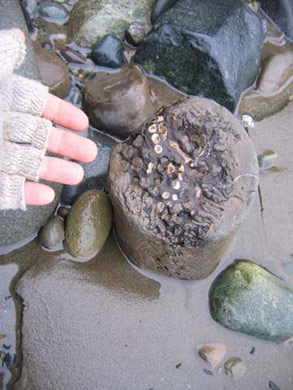
My next and last discovery was that of a large fossilized whale vertebra. It's about 4 inches tall and three across. Again, I snapped off several photos, the first showing it as found amidst the other beach rock and then next, clutched in my hand as recovered. A neat find to end the day. I kept at it until twilight had become firmly entrenched. As I made my way back to the truck, I reflected on the day. I felt good, satisfied. I'd not seen a soul, just the gulls an eagle and a heron. It'd been a fine day out and away from everything. Breathing in a little deeper, I continued on...
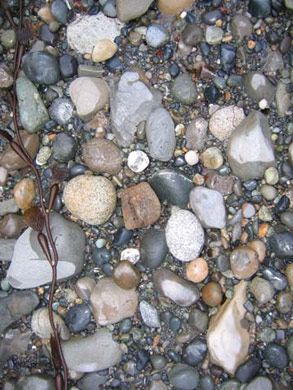
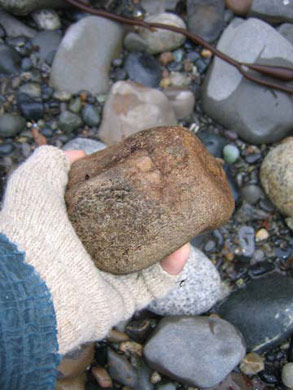
Thanks for coming along and sharing in the fun. We are all so fortunate to be surrounded by the enchanting World of Nature, for one, I'm glad I get it. I promise, it won't be long before next I set my steps towards treasure, the greatest of all being the simple experience of just getting out. Come on, let's go play...
As a last thought regarding this paper, the following two photos, while of specimens collected from this locality, these were not collected during this trip. Still, I hope you enjoy! The first photo offers a selection of crystals, pseudomorphs of calcite after ikaite, followed by a second photo, this one an exceptional example of fossil starfish.
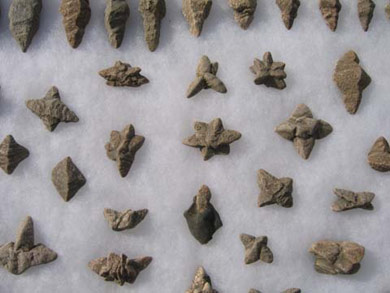
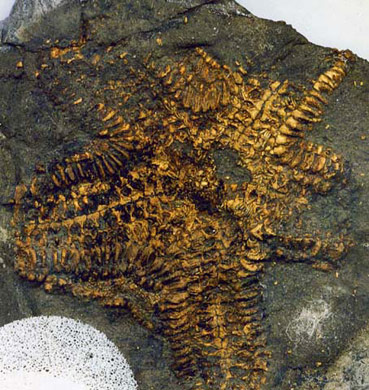
Have a great day everyone, all the very best,
John